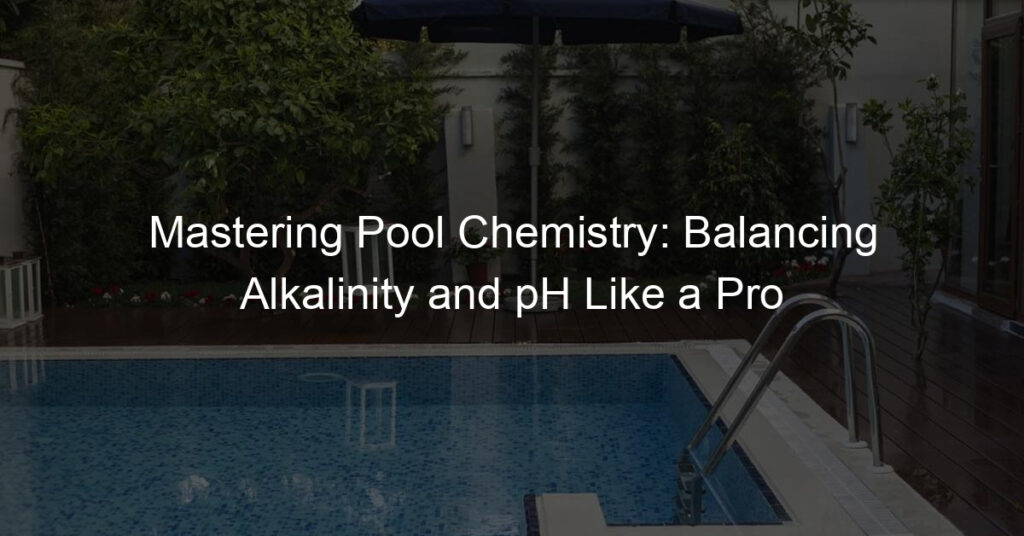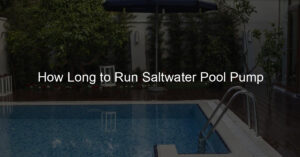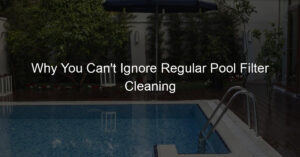Introduction to Pool Water Chemistry
Swimming pools are a great way to cool off during the hot summer months, but maintaining the right water chemistry is crucial for a safe and enjoyable swim. In this article, we will explore the importance of pool water balance and the key components of pool water chemistry.
- Understanding the Importance of Pool Water Balance
- Key Components of Pool Water Chemistry
- pH Level: This measures how acidic or basic the water is. The ideal pH level for pool water is between 7.2 and 7.8.
- Alkalinity: This helps to stabilize the pH level. The recommended alkalinity level for pool water is between 80 and 120 parts per million (ppm).
- Chlorine: This is used to kill bacteria and other harmful organisms in the water. The recommended chlorine level for pool water is between 1.0 and 3.0 ppm.
Pool water balance is all about maintaining the right levels of various chemicals in your pool. When the water is balanced, it’s safer and more comfortable for swimmers. It also helps to protect the pool equipment and surface from damage. If the water is not balanced, it can lead to problems like cloudy water, skin and eye irritation, and even damage to the pool itself.
There are several key components to pool water chemistry. These include:
By understanding and managing these key components, you can maintain a healthy and enjoyable swimming environment.
In the following sections, we will delve deeper into the topics of pool alkalinity and pH balance, and explore how they interact with each other. We will also look at real-life case studies of pool water balance issues and their solutions, and wrap up with key takeaways to help you master pool chemical balance. So, let’s dive in!
Understanding Pool Alkalinity Balance
When it comes to maintaining a clean and safe swimming pool, understanding the balance of alkalinity is key. But what exactly is pool alkalinity and why is it so important? Let’s dive in and find out.
- What is pool alkalinity?
- Why maintaining pool alkalinity is crucial
Pool alkalinity, also known as total alkalinity, is a measure of the water’s ability to neutralize acids. In simpler terms, it’s the water’s resistance to changes in pH. It’s measured in parts per million (ppm) and the ideal range for pool alkalinity is between 80 and 120 ppm.
Maintaining the right level of alkalinity in your pool is crucial for several reasons. Firstly, it helps to stabilize the pH level of the pool water. If the alkalinity is too low, the pH level can fluctuate wildly, which can lead to problems like cloudy water, scale formation, and even damage to the pool equipment. On the other hand, if the alkalinity is too high, it can cause the pH level to rise, leading to issues like poor sanitizer efficiency and skin irritation.
Secondly, maintaining the right alkalinity level can also help to prevent corrosion of metal parts and staining of the pool surfaces. Lastly, it can enhance the effectiveness of the pool’s chlorine, helping to keep the water clean and safe for swimming.
In conclusion, understanding and maintaining the right pool alkalinity balance is an essential part of pool maintenance. It not only helps to keep the water clear and sparkling but also ensures the longevity of your pool equipment and provides a safe and comfortable swimming environment.
Adjusting Pool Alkalinity
Managing the alkalinity of your pool is a vital part of maintaining its chemistry. The process involves either increasing or decreasing the alkalinity levels depending on the current state of your pool water. Here are the steps to follow:
- Steps to Increase Pool Alkalinity
- Test the Water: The first step is to test your pool water using a reliable testing kit. This will help you determine the current alkalinity level.
- Calculate the Required Amount: Once you know the current level, calculate the amount of alkalinity increaser needed. This will depend on the size of your pool and the current alkalinity level.
- Add the Alkalinity Increaser: Add the calculated amount of alkalinity increaser to the pool. It’s best to distribute it evenly across the water surface.
- Re-test the Water: After about 4 hours, re-test the water. If the alkalinity is still low, repeat the process.
- Steps to Decrease Pool Alkalinity
- Test the Water: Just like when increasing alkalinity, the first step is to test your pool water to determine the current alkalinity level.
- Calculate the Required Amount: Calculate the amount of muriatic acid or sodium bisulfate needed to lower the alkalinity. This will depend on the size of your pool and the current alkalinity level.
- Add the Chemicals: Add the calculated amount of muriatic acid or sodium bisulfate to the pool. Remember to add these chemicals slowly and in the deep end of the pool.
- Re-test the Water: After about 4 hours, re-test the water. If the alkalinity is still high, repeat the process.
If your pool’s alkalinity level is below the recommended range of 80-120 parts per million (ppm), you need to increase it. Here’s how:
If your pool’s alkalinity level is above the recommended range, you need to decrease it. Here’s how:
Remember, adjusting pool alkalinity is a delicate process. Always handle chemicals with care and keep them out of reach of children. If you’re unsure about any step, consult a pool professional.
Understanding pH Balance in Pools
When it comes to maintaining a healthy and clean swimming pool, understanding the pH balance is crucial. Let’s delve into what pH balance is and why it’s so important for your pool.
- What is pH balance?
- Importance of pH levels in pools
The term ‘pH’ stands for ‘potential of Hydrogen’. It measures how acidic or basic water is on a scale of 0 to 14. A pH of 7 is neutral, anything below 7 is acidic, and anything above 7 is basic or alkaline. The ideal pH for pool water is slightly alkaline, between 7.2 and 7.6. This range ensures optimal chemical efficiency and comfortable swimming.
Managing the pH level in your pool is essential for several reasons. Firstly, it impacts the effectiveness of the chlorine, the chemical that sanitizes your pool. When pH levels are too high, chlorine becomes less effective, which can lead to algae growth and cloudy water.
Secondly, pH levels affect the comfort of swimmers. Water that is too acidic can cause skin and eye irritation, while water that is too alkaline can cause scaling on the pool surface and plumbing equipment.
Lastly, maintaining the right pH balance helps to prevent costly repairs. Unbalanced pH levels can damage your pool’s liner, filter system, and other equipment.
In conclusion, understanding and maintaining the pH balance in your pool is a key part of pool maintenance. It ensures the effectiveness of your sanitizing chemicals, provides a comfortable swimming environment, and helps to prolong the life of your pool equipment.
Adjusting Pool pH Levels
Adjusting the pH levels in your pool is a crucial part of pool maintenance. It’s important to know how to both raise and lower these levels to ensure a safe and enjoyable swimming experience. Let’s explore how to do this.
- How to raise pH levels in pools
If your pool’s pH level is below 7.2, it’s considered acidic. This can cause irritation to swimmers’ eyes and skin. It can also corrode your pool equipment. Here’s how to raise the pH level:
- Step 1: Purchase a pH increaser. These are readily available at pool supply stores.
- Step 2: Follow the instructions on the package to determine the correct amount to add to your pool. This will depend on the current pH level and the size of your pool.
- Step 3: Add the pH increaser to your pool, spreading it evenly across the surface.
- Step 4: Allow the pool to circulate for at least four hours, then retest the pH level. If it’s still too low, repeat the process.
- How to lower pH levels in pools
If your pool’s pH level is above 7.8, it’s considered basic or alkaline. This can cause cloudy water and scale formation on your pool surfaces and equipment. Here’s how to lower the pH level:
- Step 1: Purchase a pH reducer. These are also available at pool supply stores.
- Step 2: Follow the instructions on the package to determine the correct amount to add to your pool. This will depend on the current pH level and the size of your pool.
- Step 3: Add the pH reducer to your pool, spreading it evenly across the surface.
- Step 4: Allow the pool to circulate for at least four hours, then retest the pH level. If it’s still too high, repeat the process.
Remember, maintaining the right pH level in your pool is crucial for the health of the swimmers and the longevity of your pool equipment. Regular testing and adjustments will help keep your pool in top condition.
Interplay between Pool Alkalinity and pH
When it comes to maintaining a healthy and clear swimming pool, understanding the relationship between pool alkalinity and pH levels is crucial. These two factors are closely linked, and changes in one can significantly affect the other. Let’s delve into how this interplay works.
- How pool alkalinity affects pH levels
- How pH levels affect pool alkalinity
Alkalinity, often referred to as ‘total alkalinity’, acts as a buffer for pH. If your pool’s alkalinity is in the correct range (usually between 80 and 120 parts per million), it can help stabilize your pH levels. This means that even if substances that can change the pH are added to the water, the pH level will remain relatively stable.
However, if the alkalinity is too high, it can cause the pH level to rise, leading to cloudy water and scale formation. On the other hand, if the alkalinity is too low, it can make the pH level fluctuate wildly, leading to a condition known as ‘pH bounce’.
pH is a measure of how acidic or basic the water is. The ideal pH level for a pool is typically between 7.2 and 7.8. When the pH level is within this range, it helps maintain the effectiveness of the chlorine (the sanitizer), keeps the water clear, and provides comfort for swimmers.
However, if the pH level is too high (basic), it can decrease the effectiveness of the chlorine, cause cloudy water, and lead to scale formation. If the pH is too low (acidic), it can lead to metal corrosion and discomfort for swimmers. Both high and low pH levels can also affect the total alkalinity of the pool, making it more difficult to balance.
In conclusion, maintaining a balanced pool requires careful monitoring of both the alkalinity and pH levels. By understanding how these two factors interact, you can ensure a healthier and more enjoyable swimming environment.
| Pool Parameter | Ideal Range | Potential Problems if Out of Range |
|---|---|---|
| Alkalinity | 80-120 ppm | pH bounce, cloudy water, scale formation |
| pH | 7.2-7.8 | Decreased chlorine effectiveness, cloudy water, scale formation, metal corrosion, swimmer discomfort |
Case Studies: Pool Water Balance Issues and Solutions
Let’s delve into some real-life examples that illustrate the importance of maintaining the right balance of alkalinity and pH in your pool. We will discuss two case studies that highlight common pool water balance issues and their solutions.
- Case Study 1: High Alkalinity and Low pH
- Case Study 2: Low Alkalinity and High pH
In our first case, a pool owner named John noticed that his pool water was cloudy and the pool walls were becoming rough. Upon testing, he found that the alkalinity was too high and the pH was too low. This imbalance was causing calcium to precipitate out of the water and form scale on the pool walls.
John’s solution was to lower the alkalinity by adding an acid, which also helped to increase the pH. He then shocked the pool to remove the cloudiness. After a few days of monitoring and adjusting, the water cleared up and the scale began to dissolve. This case shows how high alkalinity and low pH can cause problems, and how they can be corrected.
In the second case, a pool owner named Sarah was struggling with green water and a strong chlorine smell. The test results showed low alkalinity and high pH. This was causing the chlorine to become less effective and allowed algae to bloom.
Sarah’s solution was to increase the alkalinity by adding a base, which also helped to lower the pH. She then shocked the pool and added an algaecide. After a few days, the water returned to a clear blue and the chlorine smell was gone. This case illustrates how low alkalinity and high pH can lead to issues, and how they can be resolved.
These case studies demonstrate that maintaining the right balance of alkalinity and pH in your pool is crucial for clear, clean water and a healthy swimming environment. Remember, regular testing and adjustment of your pool water can prevent these issues from occurring.
Key Takeaways: Mastering Pool Chemical Balance
As we conclude our exploration of pool water chemistry, let’s recap the most important points. Understanding and mastering these key takeaways will help you maintain a healthy and sparkling pool.
- Importance of Regular Pool Water Testing
- Understanding the Relationship Between Alkalinity and pH
- Proper Pool Maintenance Practices
Regular pool water testing is crucial to maintaining a safe and clean swimming environment. It helps you detect any imbalances early, preventing potential health risks and damage to your pool equipment. As per the Centers for Disease Control and Prevention (CDC), pool water should be tested at least twice a week.
Alkalinity and pH are two critical aspects of pool water balance. Alkalinity acts as a pH buffer, preventing sudden pH swings. A balanced alkalinity level helps maintain a stable pH level, which is essential for the effectiveness of chlorine and the comfort of swimmers.
Proper pool maintenance goes beyond just balancing the water chemistry. It includes regular cleaning, ensuring proper circulation and filtration, and timely equipment checks. By following these practices, you can extend the life of your pool, save on costly repairs, and enjoy a safe and pleasant swimming experience.
| Key Takeaway | Why It’s Important |
|---|---|
| Regular Pool Water Testing | Helps detect imbalances early, preventing potential health risks and damage to pool equipment. |
| Understanding Alkalinity and pH | Helps maintain a stable pH level, which is essential for the effectiveness of chlorine and swimmer comfort. |
| Proper Pool Maintenance Practices | Extends the life of your pool, saves on costly repairs, and ensures a safe and pleasant swimming experience. |
Remember, mastering pool chemical balance is an art. It requires patience, regular monitoring, and a good understanding of pool water chemistry. But the reward is a crystal-clear pool that’s safe and enjoyable for everyone.
Conclusion: The Art of Pool Water Balance
Mastering the art of pool water balance is no small feat. It requires a solid understanding of pool chemistry, careful monitoring, and regular maintenance. But with the right knowledge and tools, you can maintain a healthy and sparkling pool that’s safe for everyone to enjoy.
- Recap of mastering pool chemistry
- Final thoughts and advice for maintaining pool water balance
Throughout this article, we’ve delved into the intricacies of pool water chemistry. We’ve learned about the importance of maintaining proper alkalinity and pH balance, and how these two factors interact with each other. We’ve also looked at real-life case studies that highlight common pool water balance issues and their solutions.
Remember, the key to mastering pool chemistry lies in regular testing and adjustment. By keeping a close eye on your pool’s chemistry, you can prevent problems before they occur and ensure your pool remains clean and safe.
As we conclude, it’s important to remember that maintaining pool water balance is an ongoing task. It’s not something you do once and forget about. Regular testing and adjustments are crucial to keeping your pool in top shape.
Finally, don’t be afraid to seek professional help if you’re unsure about something. Pool maintenance can be complex, but with the right knowledge and assistance, you can master the art of pool water balance.
Remember, a well-balanced pool is not only beautiful to look at, but it’s also safe and enjoyable for everyone. So, take the time to understand your pool’s chemistry and make the necessary adjustments. Your pool, and everyone who enjoys it, will thank you.














